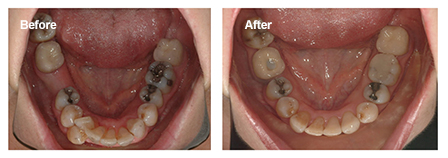
347 MILLION PEOPLE WORLDWIDE have diabetes, and that number grows every year. Diabetes affects all areas of people’s health, from the skin to the kidneys. Diabetes can also cause severe dental health issues.
Diabetes Increases Gum Disease Risk
Research has shown that people with diabetes are more likely to develop periodontal disease. Periodontal disease is a serious health problem that can lead to bone and tooth loss if not properly managed.
Periodontitis Can Also Reduce One’s Ability To Control Blood Sugar
Periodontitis (an advanced stage of gum disease) can make blood sugar levels spike and fluctuate. Additional research suggests that when diabetic patients gain control of gum disease, they can also gain better control of their diabetes.
Can Periodontal Disease Affect Orthodontic Treatment?
Many patients with diabetes needs orthodontic treatment. When bone is lost surrounding teeth, often these teeth move into undesirable positions. Bone loss in the presence of inflammation, as found in periodontitis, can result in unpredictable orthodontic tooth movement during orthodontic treatment.
That’s why, at Gorczyca Orthodontics, we send every adult orthodontic patient for a thorough periodontal examination with a periodontist prior to starting active orthodontic therapy.
Periodontist, Dr. Nancy Dubuk of Deer Valley Professionals, 5201 Deer Valley Road in Antioch, California says:
“A diabetic patient seeking orthodontic treatment can be stable with blood sugars under control with proper monitoring. These patients can maintain their periodontal health well, as long as they are on a good oral hygiene maintenance schedule, both at home and professionally. Once these are established, they can begin orthodontic treatment.”
Help Us Raise Awareness About Diabetes-Related Periodontal Disease
What Can You Do To Prevent Periodontal Disease?
Patients can brush and floss twice per day to prevent periodontal disease. Be sure to have professional cleanings done at least twice per year with your dentist. Ask your dentist to complete a thorough periodontal exam, which includes pockets probing measurements and full mouth series radiographs. If bony pockets deeper than 4 mm exist, early treatment by a periodontist can help prevent further bone loss.
For more information about periodontal disease, contact the American Academy of Periodontology at www.perio.org. To find an orthodontist near you, visit the American Association of Orthodontists at www.mylifemysmile.org.
Oral hygiene maintenance and beautifully white straight teeth will help you prevent the danger of of diabetes associated periodontal disease. Let your periodontist and orthodontist help you achieve a beautiful smile.
To learn more about adult orthodontics, call us at Gorczyca Orthodontics (925) 757-9000 or visit us at www.clubbraces.com.
Share This Information With Someone You Know
Most of us know at least one person who is affected by these diseases. If you have a friend, family member, neighbor, or coworker who has diabetes or periodontitis, share this information with them! It’s essential that they understand the relationship between these two things—and, what they can do to help improve their situation.
Thank you for your trust in our practice!

















